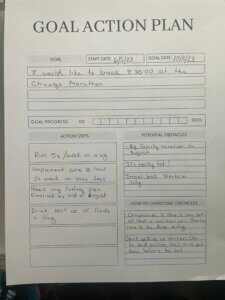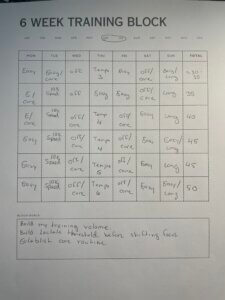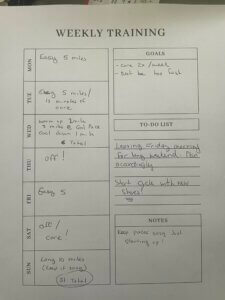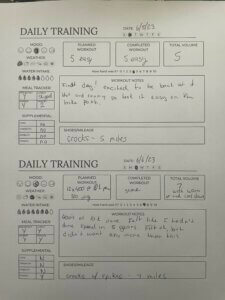How to use your training journal

This journal was created for the runner who wants to work through what they want to accomplish, how they are going to do it, track their progress, then reflect so they can continue progressing into the future.
How I approached it was to start with the big picture goal of what it was I wanted to accomplish, and then work down to a smaller and smaller view until I got down to what I was getting done each day. Then reverse it with daily, weekly, and then segment reflection. That way, I could create a plan, and reasonable goals to reach my bigger goals. Then, I could reflect on what I did right, and what I did wrong, then fine-tune it to move forward.
The 30,000-foot view: The Goal Action Plan
This, there are a few ways to approach. You have multiple sheets of this, so maybe you have something like a 1-3 year goal. For many of you, that might mean running a Boston Qualifier. That might be your first goal sheet. From there, your next one might be to run a marathon at 3:30. Maybe it’s lowering your 5k and 10k PR so that running the BQ time feels more comfortable. You get the idea, but the main takeaway is that it’s a bigger goal you are trying to accomplish. There’s not right answer to this, just something that you want to accomplish over the next year, or so. For example, let’s say that my goal is to run 3:30 at the Chicago Marathon in the fall.
Below that space, you’ll have a place to track progress. For some goals, you might not have an objective way to track, but you can come back to this as you work through your training and use it to reflect and see if you have taken steps toward reaching this goal.
The second half of this sheet is where you will have to dig a little deeper into your planning. Along the left side, you’ll have your actionable steps. What good is a goa if you don’t have a plan to get there? You have six lines here, but think about two or three really important things you will need to do, in order to reach your goal.
Using our 3:30 example, let’s think of some things that we need to really get down in order for us to give ourselves a chance. Here are some examples of steps we can measure along the way.
- Run at least 5 days a week, on average
- Implement a core routine and average 2x per week
- Develop a fuel plan and practice most long runs and marathon tempo runs
- Drink 100 oz of water a day.
Personally, I’d make a list of potential areas that you could focus on, then dial it into a few. Adding too many can be overwhelming, so either add a couple that you know can give you easy wins, and maybe another you know will take more work on your end.
From there, you could always break down items from your action steps and create a new goal sheet for each item to break down even further.
Lastly, on the right side of the bottom half, you have potential obstacles. It’s good to think through what could be hang-ups here. I’d I’m training for an October marathon, what are some potential obstacles I may encounter?
- Family vacations
- Workouts in the heat
- Balancing my kid’s sporting activities with training
These are the most common in my life and for my athletes, too. Yours may be different, but you get the idea. So, in order to navigate these, what am I going to do when these come up?
- Prioritize 1-2 workouts during vacation, so at least I’m not losing fitness. Try not to go overboard with local cuisine and add a few pounds.
- Adjust my times based on heat and humidity until I acclimate.
- Shift my workout days as needed. Move my runs to the early am. (This would help with 2, as well).
None of this has to be perfect and you’ll probably hit a snag that you didn’t even see coming. The point is to lay it out the best you can so that you can maneuver from what you can and not just go into a mode of slipping things altogether because you are overwhelmed.

The 20,000 Foot View: 6 Week Training Block
If you follow anything I discuss in regard to training, you know that it takes anywhere from 4-6 weeks to adapt to a training load. So, here is where we start putting the plan into action. I recommend using a pencil to fill this out as it may change from time to time. This is what I would consider a first draft. If you are following a training plan, it’s pretty easy, you can just copy it into your training journal and have it as a reference. If you are creating your own training plan, I really find this useful as we can write out a block of training, look at it from a bigger picture, and then adjust as we see it laid out in front of us. If you are anything like me, something sounds like a good idea in my head, but as soon as I write it out, the visual expose some glaring issues!
The sheets themselves are pretty straightforward. Circle the month(s) you are at along the top. Then, plug in your overall plan each day. It might not even be that specific. For example, you might just list Easy day, Off Day, Speed, Tempo, Long, or something like that. Maybe you’ll have a general idea of mileage and can drop that in. The “Total” column can be an actual number or just a goal mileage for the week. Again, this is more for beginning to shape out the training. The next sheet will provide a space to narrow this down even further to get a detailed view.

The 10,000 view: Weekly Training
Now you can take your outline and put it into a more detailed view. Here, you can take your rough outline and put in the details for the upcoming week. Along the left side of the sheet, you have your daily breakdown for the week. Here’s where you can put in exactly what you are looking to get done for the week. In the upper right, you can write out your main goals for the week. Below that, is a To-Do list. It can include things specific to training, but it may also include things outside of running. For example, if you have a big presentation at work this week, you can note it in here. Having it in front of you and recognizing it as a potential hangup to the week (from a training standpoint) can help you adjust early so that you aren’t overwhelmed on a day you may have had a workout and then a major event in life. Lastly, any notes you might have before the week starts can be jotted down in the last section.

Approaching the Tarmac: Daily Training
Here I have included everything you need to track your daily training to have a comprehensive overall view of your training. Most, of these are pretty self-explanatory, if not all. The biggest thing here is to be consistent with filling out the items. For example, if you aren’t drinking enough fluid, and you are noting it, it’s going to be much easier to recognize than if only fill it out sporadically. It might not seem like a big deal, but if you are self-coached, and feeling fatigued, then noticing this will be important for correcting the issue.

Landed: The Notes
There are a few Notes pages in the back of the journal. The intention is to be used as a reflection after both an important race and a training segment. I separate these because you may have a poor race, but the segment was good. Take your time and look over everything and put it out there. Taking honest assessments will help get you to where you want to be much quicker than making the same mistakes repeatedly. Take these notes and use them as you work through the year you are in and then into the next journal the following year.
Best of luck with your training!
To purchase a 52 week training journal: https://amzn.to/452KMQi
To check out our training plans:https://bit.ly/3YyDLnJ
Be sure to join our community: https://bit.ly/3Qy27fy



